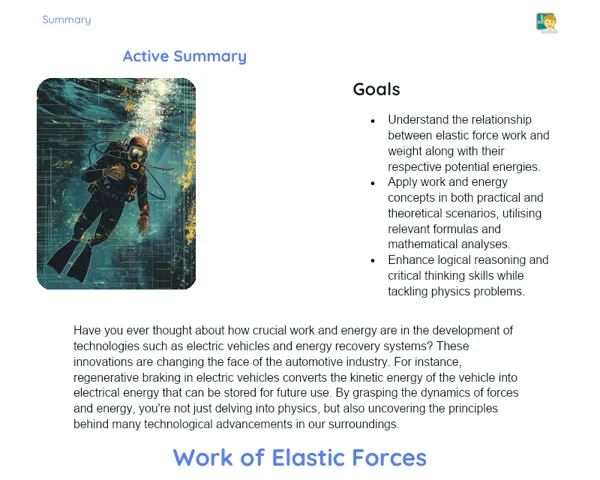Goals
1. Get to grips with the concept of thermodynamic cycles and how they are applied in real-world scenarios.
2. Tackle problems related to heat transfer, internal energy, and work done within thermodynamic cycles.
Contextualization
Thermodynamic cycles are pivotal for understanding how various machines operate, ranging from car engines to power plants. These cycles allow us to grasp how energy changes from one form to another and how we can utilize it in an efficient manner. For instance, the Carnot cycle, one of the most well-known thermodynamic cycles, plays a vital role in developing engines that are both more efficient and environmentally friendly. Similarly, the Rankine cycle is extensively used in thermal power plants for generating electricity from heat.
Subject Relevance
To Remember!
Thermodynamic Cycle
A thermodynamic cycle comprises a sequence of processes that a system undergoes, culminating in a return to its original state. Throughout a cycle, the system can perform work and engage in heat exchange with its surroundings. Grasping thermodynamic cycles is vital for analyzing and optimizing engines and other thermal devices.
-
Thermodynamic cycles can be illustrated through pressure-volume (PV) or temperature-entropy (TS) diagrams.
-
The cycle's processes often include steps like compression, expansion, heating, and cooling.
-
The efficiency of a thermodynamic cycle reflects how effectively it converts heat into useful work.
Carnot Cycle
The Carnot cycle serves as a theoretical standard that sets the highest efficiency attainable by any thermodynamic cycle. It consists of two isothermal processes (one expansion and one compression) and two adiabatic processes (also expansion and compression).
-
It serves as an idealized cycle, acting as a benchmark for maximum possible efficiency.
-
No actual cycle can surpass the Carnot cycle's efficiency when operating between the same temperature limits.
-
The Carnot cycle underscores the principles of the second law of thermodynamics.
Rankine Cycle
The Rankine cycle is a thermodynamic cycle prominently utilized in power generation systems like thermal power plants. It involves the evaporation of a liquid (generally water) in a boiler, the vapor's expansion in a turbine, the vapor's condensation in a condenser, and the liquid's compression in a pump.
-
Widely employed in power plants, it converts heat into mechanical work.
-
The Rankine cycle can be enhanced for efficiency, such as through reheating and regeneration.
-
The operating temperatures of the boiler and condenser significantly affect the Rankine cycle's efficiency.
Practical Applications
-
Automobile engines utilize thermodynamic cycles, including the Otto cycle (for petrol engines) and the Diesel cycle (for diesel engines), to convert fuel into mechanical work.
-
Thermal power plants apply the Rankine cycle to generate electricity from heat derived from both fossil fuels and renewable sources.
-
Refrigeration and air conditioning systems rely on thermodynamic cycles, such as the vapor compression cycle, to extract heat from a space and maintain it at a specific temperature.
Key Terms
-
Thermodynamic Cycle: A series of processes that a system completes, returning to its initial state.
-
Carnot Cycle: A theoretical model establishing the maximum efficiency limit in thermodynamic cycles.
-
Rankine Cycle: The cycle employed in thermal power plants for transforming heat into mechanical work.
-
Energy Efficiency: A measure of how effectively a thermodynamic cycle converts heat into useful work.
-
Heat Transfer: The energy that is exchanged between the system and its environment due to a temperature difference.
-
Internal Energy: The total energy within a system attributed to the motion and interaction of its constituent particles.
-
Work Done: The energy transferred from a system to its surroundings through mechanical forces.
Questions for Reflections
-
How can a deeper understanding of thermodynamic cycles aid in the creation of more efficient and sustainable technologies?
-
What are the key differences between the Carnot, Rankine, Otto, and Diesel cycles? How do these variations influence their real-world applications?
-
In what ways can enhancements in the efficiency of thermodynamic cycles impact global energy sustainability?
Practical Challenge: Simulating a Thermodynamic Cycle
In this mini-challenge, you'll get the chance to apply your insights about thermodynamic cycles by building and simulating a simplified thermodynamic cycle.
Instructions
-
Create groups of 4 to 5 individuals.
-
Utilize the provided materials (syringes, balloons, rubber tubes, water, tape, and thermometers) to construct a physical model of a thermodynamic cycle, such as the Carnot cycle or the Otto cycle.
-
Follow the steps of your chosen cycle: adiabatic compression, adiabatic expansion, isochoric heating, and isochoric cooling.
-
Present your model to the class, detailing the processes involved and illustrating how each step of the cycle is exemplified.
-
Share the challenges faced and the insights gained during the model construction process.



